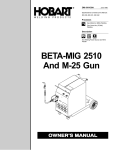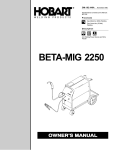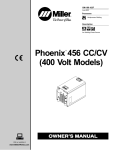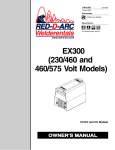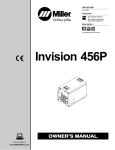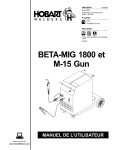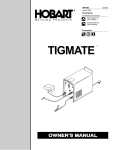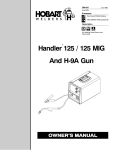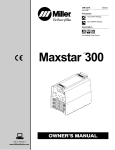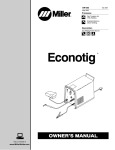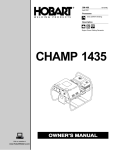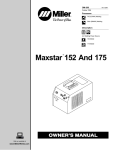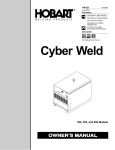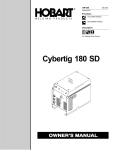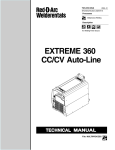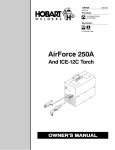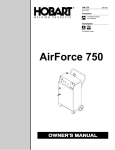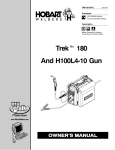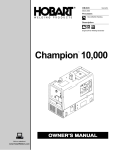Download BETA-MIG 2510 - Hobart Welders
Transcript
OM-185 158A May 1997 Eff. w/Serial Number KH438994 Specifications Covered by this Manual: 903 533, 903 562, 903 563 Processes Gas Metal Arc (MIG) Welding Flux Cored Arc (FCAW) Welding Description Arc Welding Power Source and Wire Feeder BETA-MIG 2510 1. Safety Precautions – Read Before Using 1.1 Symbol Usage OM-185 158A - 5/97, safety_som 4/97 Means Warning! Watch Out! There are possible hazards with this procedure! The possible hazards are shown in the adjoining symbols. Y Marks a special safety message. . Means “Note”; not safety related. 1.2 This group of symbols means Warning! Watch Out! possible ELECTRIC SHOCK, MOVING PARTS, and HOT PARTS hazards. Consult symbols and related instructions below for necessary actions to avoid the hazards. Arc Welding Hazards Y The symbols shown below are used throughout this manual to call attention to and identify possible hazards. When you see the symbol, watch out, and follow the related instructions to avoid the hazard. The safety information given below is only a summary of the more complete safety information found in the Safety Standards listed in Section 1.4. Read and follow all Safety Standards. Y Only qualified persons should install, operate, maintain, and repair this unit. Y During operation, keep everybody, especially children, away. ELECTRIC SHOCK can kill. Touching live electrical parts can cause fatal shocks or severe burns. The electrode and work circuit is electrically live whenever the output is on. The input power circuit and machine internal circuits are also live when power is on. In semiautomatic or automatic wire welding, the wire, wire reel, drive roll housing, and all metal parts touching the welding wire are electrically live. Incorrectly installed or improperly grounded equipment is a hazard. D Do not touch live electrical parts. D Wear dry, hole-free insulating gloves and body protection. D Insulate yourself from work and ground using dry insulating mats or covers big enough to prevent any physical contact with the work or ground. D Do not use AC output in damp areas, if movement is confined, or if there is a danger of falling. D Use AC output ONLY if required for the welding process. D If AC output is required, use remote output control if present on unit. D Disconnect input power or stop engine before installing or servicing this equipment. Lockout/tagout input power according to OSHA 29 CFR 1910.147 (see Safety Standards). D Properly install and ground this equipment according to its Owner’s Manual and national, state, and local codes. D Always verify the supply ground – check and be sure that input power cord ground wire is properly connected to ground terminal in disconnect box or that cord plug is connected to a properly grounded receptacle outlet. D When making input connections, attach proper grounding conductor first – double-check connections. D Frequently inspect input power cord for damage or bare wiring – replace cord immediately if damaged – bare wiring can kill. D Turn off all equipment when not in use. D Do not use worn, damaged, undersized, or poorly spliced cables. OM-185 158 D Do not drape cables over your body. D If earth grounding of the workpiece is required, ground it directly with a separate cable – do not use work clamp or work cable. D Do not touch electrode if you are in contact with the work, ground, or another electrode from a different machine. D Use only well-maintained equipment. Repair or replace damaged parts at once. Maintain unit according to manual. D Wear a safety harness if working above floor level. D Keep all panels and covers securely in place. D Clamp work cable with good metal-to-metal contact to workpiece or worktable as near the weld as practical. D Insulate work clamp when not connected to workpiece to prevent contact with any metal object. SIGNIFICANT DC VOLTAGE exists after removal of input power on inverters. D Turn Off inverter, disconnect input power, and discharge input capacitors according to instructions in Maintenance Section before touching any parts. FUMES AND GASES can be hazardous. Welding produces fumes and gases. Breathing these fumes and gases can be hazardous to your health. D Keep your head out of the fumes. Do not breathe the fumes. D If inside, ventilate the area and/or use exhaust at the arc to remove welding fumes and gases. D If ventilation is poor, use an approved air-supplied respirator. D Read the Material Safety Data Sheets (MSDSs) and the manufacturer’s instructions for metals, consumables, coatings, cleaners, and degreasers. D Work in a confined space only if it is well ventilated, or while wearing an air-supplied respirator. Always have a trained watchperson nearby. Welding fumes and gases can displace air and lower the oxygen level causing injury or death. Be sure the breathing air is safe. D Do not weld in locations near degreasing, cleaning, or spraying operations. The heat and rays of the arc can react with vapors to form highly toxic and irritating gases. D Do not weld on coated metals, such as galvanized, lead, or cadmium plated steel, unless the coating is removed from the weld area, the area is well ventilated, and if necessary, while wearing an air-supplied respirator. The coatings and any metals containing these elements can give off toxic fumes if welded. 1 ARC RAYS can burn eyes and skin. Arc rays from the welding process produce intense visible and invisible (ultraviolet and infrared) rays that can burn eyes and skin. Sparks fly off from the weld. D Wear a welding helmet fitted with a proper shade of filter to protect your face and eyes when welding or watching (see ANSI Z49.1 and Z87.1 listed in Safety Standards). D Wear approved safety glasses with side shields under your helmet. D Use protective screens or barriers to protect others from flash and glare; warn others not to watch the arc. D Wear protective clothing made from durable, flame-resistant material (leather and wool) and foot protection. BUILDUP OF GAS can injure or kill. D Shut off shielding gas supply when not in use. D Always ventilate confined spaces or use approved air-supplied respirator. HOT PARTS can cause severe burns. D Do not touch hot parts bare handed. D Allow cooling period before working on gun or torch. MAGNETIC FIELDS can affect pacemakers. WELDING can cause fire or explosion. Welding on closed containers, such as tanks, drums, or pipes, can cause them to blow up. Sparks can fly off from the welding arc. The flying sparks, hot workpiece, and hot equipment can cause fires and burns. Accidental contact of electrode to metal objects can cause sparks, explosion, overheating, or fire. Check and be sure the area is safe before doing any welding. D Protect yourself and others from flying sparks and hot metal. D Do not weld where flying sparks can strike flammable material. D Remove all flammables within 35 ft (10.7 m) of the welding arc. If this is not possible, tightly cover them with approved covers. D Be alert that welding sparks and hot materials from welding can easily go through small cracks and openings to adjacent areas. D Watch for fire, and keep a fire extinguisher nearby. D Be aware that welding on a ceiling, floor, bulkhead, or partition can cause fire on the hidden side. D Do not weld on closed containers such as tanks, drums, or pipes, unless they are properly prepared according to AWS F4.1 (see Safety Standards). D Connect work cable to the work as close to the welding area as practical to prevent welding current from traveling long, possibly unknown paths and causing electric shock and fire hazards. D Do not use welder to thaw frozen pipes. D Remove stick electrode from holder or cut off welding wire at contact tip when not in use. D Wear oil-free protective garments such as leather gloves, heavy shirt, cuffless trousers, high shoes, and a cap. D Remove any combustibles, such as a butane lighter or matches, from your person before doing any welding. FLYING METAL can injure eyes. D Welding, chipping, wire brushing, and grinding cause sparks and flying metal. As welds cool, they can throw off slag. D Wear approved safety glasses with side shields even under your welding helmet. 2 D Pacemaker wearers keep away. D Wearers should consult their doctor before going near arc welding, gouging, or spot welding operations. NOISE can damage hearing. Noise from some processes or equipment can damage hearing. D Wear approved ear protection if noise level is high. CYLINDERS can explode if damaged. Shielding gas cylinders contain gas under high pressure. If damaged, a cylinder can explode. Since gas cylinders are normally part of the welding process, be sure to treat them carefully. D Protect compressed gas cylinders from excessive heat, mechanical shocks, slag, open flames, sparks, and arcs. D Install cylinders in an upright position by securing to a stationary support or cylinder rack to prevent falling or tipping. D Keep cylinders away from any welding or other electrical circuits. D Never drape a welding torch over a gas cylinder. D Never allow a welding electrode to touch any cylinder. D Never weld on a pressurized cylinder – explosion will result. D Use only correct shielding gas cylinders, regulators, hoses, and fittings designed for the specific application; maintain them and associated parts in good condition. D Turn face away from valve outlet when opening cylinder valve. D Keep protective cap in place over valve except when cylinder is in use or connected for use. D Read and follow instructions on compressed gas cylinders, associated equipment, and CGA publication P-1 listed in Safety Standards. OM-185 158 1.3 Additional Symbols for Installation, Operation, and Maintenance FIRE OR EXPLOSION hazard. MOVING PARTS can cause injury. D Do not install or place unit on, over, or near combustible surfaces. D Do not install unit near flammables. D Do not overload building wiring – be sure power supply system is properly sized, rated, and protected to handle this unit. D Keep away from moving parts such as fans. D Keep all doors, panels, covers, and guards closed and securely in place. FALLING UNIT can cause injury. H.F. RADIATION can cause interference. D Use lifting eye to lift unit only, NOT running gear, gas cylinders, or any other accessories. D Use equipment of adequate capacity to lift and support unit. D If using lift forks to move unit, be sure forks are long enough to extend beyond opposite side of unit. D OVERUSE can cause OVERHEATING D D Allow cooling period; follow rated duty cycle. D Reduce current or reduce duty cycle before starting to weld again. D Do not block or filter airflow to unit. D D D High-frequency (H.F.) can interfere with radio navigation, safety services, computers, and communications equipment. D Have only qualified persons familiar with electronic equipment perform this installation. The user is responsible for having a qualified electrician promptly correct any interference problem resulting from the installation. If notified by the FCC about interference, stop using the equipment at once. Have the installation regularly checked and maintained. Keep high-frequency source doors and panels tightly shut, keep spark gaps at correct setting, and use grounding and shielding to minimize the possibility of interference. STATIC (ESD) can damage PC boards. D Put on grounded wrist strap BEFORE handling boards or parts. D Use proper static-proof bags and boxes to store, move, or ship PC boards. ARC WELDING can cause interference. MOVING PARTS can cause injury. D Keep away from moving parts. D Keep away from pinch points such as drive rolls. D D WELDING WIRE can cause injury. D Do not press gun trigger until instructed to do so. D Do not point gun toward any part of the body, other people, or any metal when threading welding wire. 1.4 D D D Electromagnetic energy can interfere with sensitive electronic equipment such as computers and computer-driven equipment such as robots. D Be sure all equipment in the welding area is electromagnetically compatible. To reduce possible interference, keep weld cables as short as possible, close together, and down low, such as on the floor. Locate welding operation 100 meters from any sensitive electronic equipment. Be sure this welding machine is installed and grounded according to this manual. If interference still occurs, the user must take extra measures such as moving the welding machine, using shielded cables, using line filters, or shielding the work area. Principal Safety Standards Safety in Welding and Cutting, ANSI Standard Z49.1, from American Welding Society, 550 N.W. LeJeune Rd, Miami FL 33126 Safety and Health Standards, OSHA 29 CFR 1910, from Superintendent of Documents, U.S. Government Printing Office, Washington, D.C. 20402. Recommended Safe Practices for the Preparation for Welding and Cutting of Containers That Have Held Hazardous Substances, American Welding Society Standard AWS F4.1, from American Welding Society, 550 N.W. LeJeune Rd, Miami, FL 33126 National Electrical Code, NFPA Standard 70, from National Fire Protection Association, Batterymarch Park, Quincy, MA 02269. OM-185 158 Safe Handling of Compressed Gases in Cylinders, CGA Pamphlet P-1, from Compressed Gas Association, 1235 Jefferson Davis Highway, Suite 501, Arlington, VA 22202. Code for Safety in Welding and Cutting, CSA Standard W117.2, from Canadian Standards Association, Standards Sales, 178 Rexdale Boulevard, Rexdale, Ontario, Canada M9W 1R3. Safe Practices For Occupation And Educational Eye And Face Protection, ANSI Standard Z87.1, from American National Standards Institute, 1430 Broadway, New York, NY 10018. Cutting And Welding Processes, NFPA Standard 51B, from National Fire Protection Association, Batterymarch Park, Quincy, MA 02269. 3 1.5 EMF Information Considerations About Welding And The Effects Of Low Frequency Electric And Magnetic Fields To reduce magnetic fields in the workplace, use the following procedures: The following is a quotation from the General Conclusions Section of the U.S. Congress, Office of Technology Assessment, Biological Effects of Power Frequency Electric & Magnetic Fields – Background Paper, OTA-BP-E-53 (Washington, DC: U.S. Government Printing Office, May 1989): “. . . there is now a very large volume of scientific findings based on experiments at the cellular level and from studies with animals and people which clearly establish that low frequency magnetic fields can interact with, and produce changes in, biological systems. While most of this work is of very high quality, the results are complex. Current scientific understanding does not yet allow us to interpret the evidence in a single coherent framework. Even more frustrating, it does not yet allow us to draw definite conclusions about questions of possible risk or to offer clear science-based advice on strategies to minimize or avoid potential risks.” 1. Keep cables close together by twisting or taping them. 4 2. Arrange cables to one side and away from the operator. 3. Do not coil or drape cables around the body. 4. Keep welding power source and cables as far away from operator as practical. 5. Connect work clamp to workpiece as close to the weld as possible. About Pacemakers: The above procedures are also recommended for pacemaker wearers. Consult your doctor for complete information. OM-185 158 1. Consignes de sécurité utilisation 1.1 – lire avant Signification des symboles safety_som_fre 4/97 Signifie Mise en garde ! Soyez vigilant ! Cette procédure présente des risques de danger ! Ceux-ci sont identifiés par des symboles adjacents aux directives. Y Identifie un message de sécurité particulier. . Signifie NOTA ; n’est pas relatif à la sécurité. 1.2 Ce groupe de symboles signifie Mise en garde ! Soyez vigilant ! Il y a des risques de danger reliés aux CHOCS ÉLECTRIQUES, aux PIÈCES EN MOUVEMENT et aux PIÈCES CHAUDES. Reportez-vous aux symboles et aux directives ci-dessous afin de connaître les mesures à prendre pour éviter tout danger. Dangers relatifs au soudage à l’arc Y Les symboles présentés ci-après sont utilisés tout au long du présent manuel pour attirer votre attention et identifier les risques de danger. Lorsque vous voyez un symbole, soyez vigilant et suivez les directives mentionnées afin d’éviter tout danger. Les consignes de sécurité présentées ci-après ne font que résumer l’information contenue dans les normes de sécurité énumérées à la section 1-5. Veuillez lire et respecter toutes ces normes de sécurité. Y L’installation, l’utilisation, l’entretien et les réparations ne doivent être confiés qu’à des personnes qualifiées. Y Au cours de l’utilisation, tenir toute personne à l’écart et plus particulièrement les enfants. UN CHOC ÉLECTRIQUE peut tuer. Un simple contact avec des pièces électriques peut provoquer une électrocution ou des blessures graves. L’électrode et le circuit de soudage sont sous tension dès que l’appareil est sur ON. Le circuit d’entrée et les circuits internes de l’appareil sont également sous tension à ce moment-là. En soudage semi-automatique ou automatique, le fil, le dévidoir, le logement des galets d’entraînement et les pièces métalliques en contact avec le fil de soudage sont sous tension. Des matériels mal installés ou mal mis à la terre présentent un danger. D Si la pièce soudée doit être mise à la terre, le faire directement avec un câble distinct – ne pas utiliser le connecteur de pièce ou le câble de retour. D Ne pas toucher l’électrode quand on est en contact avec la pièce, la terre ou une électrode provenant d’une autre machine. D N’utiliser qu’un matériel en bon état. Réparer ou remplacer sur-lechamp les pièces endommagées. Entretenir l’appareil conformément à ce manuel. D Porter un harnais de sécurité quand on travaille en hauteur. D Maintenir solidement en place tous les panneaux et capots. D Fixer le câble de retour de façon à obtenir un bon contact métal-métal avec la pièce à souder ou la table de travail, le plus près possible de la soudure. D Il y a DU COURANT CONTINU IMPORTANT dans les convertisseurs après la suppression de l’alimentation électrique. D Arrêter les convertisseurs, débrancher le courant électrique, et décharger les condensateurs d’alimentation selon les instructions indiquées dans la partie entretien avant de toucher les pièces. D Ne jamais toucher les pièces électriques sous tension. D Porter des gants et des vêtements de protection secs ne comportant pas de trous. D S’isoler de la pièce et de la terre au moyen de tapis ou d’autres moyens isolants suffisamment grands pour empêcher le contact physique éventuel avec la pièce ou la terre. D D D Ne pas se servir de source électrique àcourant électrique dans les zones humides, dans les endroits confinés ou là où on risque de tomber. Se servir d’une source électrique àcourant électrique UNIQUEMENT si le procédé de soudage le demande. Si l’utilisation d’une source électrique àcourant électrique s’avère nécessaire, se servir de la fonction de télécommande si l’appareil en est équipé. D Couper l’alimentation ou arrêter le moteur avant de procéder à l’installation, à la réparation ou à l’entretien de l’appareil. Déverrouiller l’alimentation selon la norme OSHA 29 CFR 1910.147 (voir normes de sécurité). D Installer et mettre à la terre correctement cet appareil conformément à son manuel d’utilisation et aux codes nationaux, provinciaux et municipaux. D Toujours vérifier la terre du cordon d’alimentation – Vérifier et s’assurer que le fil de terre du cordon d’alimentation est bien raccordé à la borne de terre du sectionneur ou que la fiche du cordon est raccordée à une prise correctement mise à la terre. D En effectuant les raccordements d’entrée fixer d’abord le conducteur de mise à la terre approprié et contre-vérifier les connexions. D Vérifier fréquemment le cordon d’alimentation pour voir s’il n’est pas endommagé ou dénudé – remplacer le cordon immédiatement s’il est endommagé – un câble dénudé peut provoquer une électrocution. D Mettre l’appareil hors tension quand on ne l’utilise pas. D Ne pas utiliser des câbles usés, endommagés, de grosseur insuffisante ou mal épissés. D Ne pas enrouler les câbles autour du corps. OM-185 158 Isoler la pince de masse quand pas mis à la pièce pour éviter le contact avec tout objet métallique. LES FUMÉES ET LES GAZ peuvent être dangereux. Le soudage génère des fumées et des gaz. Leur inhalation peut être dangereux pour votre santé. D D D D D D D Eloigner votre tête des fumées. Ne pas respirer les fumées. A l’intérieur, ventiler la zone et/ou utiliser un échappement au niveau de l’arc pour l’évacuation des fumées et des gaz de soudage. Si la ventilation est insuffisante, utiliser un respirateur à alimentation d’air homologué. Lire les spécifications de sécurité des matériaux (MSDSs) et les instructions du fabricant concernant les métaux, les consommables, les revêtements, les nettoyants et les dégraisseurs. Travailler dans un espace fermé seulement s’il est bien ventilé ou en portant un respirateur à alimentation d’air. Demander toujours à un surveillant dûment formé de se tenir à proximité. Des fumées et des gaz de soudage peuvent déplacer l’air et abaisser le niveau d’oxygène provoquant des blessures ou des accidents mortels. S’assurer que l’air de respiration ne présente aucun danger. Ne pas souder dans des endroits situés à proximité d’opérations de dégraissage, de nettoyage ou de pulvérisation. La chaleur et les rayons de l’arc peuvent réagir en présence de vapeurs et former des gaz hautement toxiques et irritants. Ne pas souder des métaux munis d’un revêtement, tels que l’acier galvanisé, plaqué en plomb ou au cadmium à moins que le revêtement n’ait été enlevé dans la zone de soudure, que l’endroit soit bien ventilé, et si nécessaire, en portant un respirateur à alimentation d’air. Les revêtements et tous les métaux renfermant ces éléments peuvent dégager des fumées toxiques en cas de soudage. 5 LES RAYONS DE L’ARC peuvent provoquer des brûlures dans les yeux et sur la peau. Le rayonnement de l’arc du procédé de soudage génère des rayons visibles et invisibles intenses (ultraviolets et infrarouges) susceptibles de provoquer des brûlures dans les yeux et sur la peau. Des étincelles sont projetées pendant le soudage. D Porter un casque de soudage muni d’un écran de filtre approprié pour protéger votre visage et vos yeux pendant le soudage ou pour regarder (voir ANSI Z49.1 et Z87.1 énuméré dans les normes de sécurité). D Porter des protections approuvés pour les oreilles si le niveau sondre est trop élevé. D Utiliser des écrans ou des barrières pour protéger des tiers de l’éclair et de l’éblouissement; demander aux autres personnes de ne pas regarder l’arc. D Porter des vêtements de protection constitué dans une matière durable, résistant au feu (cuir ou laine) et une protection des pieds. LE SOUDAGE peut provoquer un incendie ou une explosion. Le soudage effectué sur des conteneurs fermés tels que des réservoirs, tambours ou des conduites peut provoquer leur éclatement. Des étincelles peuvent être projetées de l’arc de soudure. La projection d’étincelles, des pièces chaudes et des équipements chauds peut provoquer des incendies et des brûlures. Le contact accidentel de l’électrode avec des objets métalliques peut provoquer des étincelles, une explosion, un surchauffement ou un incendie. Avant de commencer le soudage, vérifier et s’assurer que l’endroit ne présente pas de danger. D Se protéger et d’autres personnes de la projection d’étincelles et de métal chaud. D Ne pas souder dans un endroit là où des étincelles peuvent tomber sur des substances inflammables. D Déplacer toutes les substances inflammables à une distance de 10,7 m de l’arc de soudage. En cas d’impossibilité les recouvrir soigneusement avec des protections homologués. D Des étincelles et des matériaux chauds du soudage peuvent facilement passer dans d’autres zones en traversant de petites fissures et des ouvertures. D Surveiller tout déclenchement d’incendie et tenir un extincteur à proximité. D Le soudage effectué sur un plafond, plancher, paroi ou séparation peut déclencher un incendie de l’autre côté. D Ne pas effectuer le soudage sur des conteneurs fermés tels que des réservoirs, tambours, ou conduites, à moins qu’ils n’aient été préparés correctement conformément à AWS F4.1 (voir les normes de sécurité). D Brancher le câble sur la pièce le plus près possible de la zone de soudage pour éviter le transport du courant sur une longue distance par des chemins inconnus éventuels en provoquant des risques d’électrocution et d’incendie. D Ne pas utiliser le poste de soudage pour dégeler des conduites gelées. D En cas de non utilisation, enlever la baguette d’électrode du porteélectrode ou couper le fil à la pointe de contact. D Porter des vêtements de protection dépourvus d’huile tels que des gants en cuir, une chemise en matériau lourd, des pantalons sans revers, des chaussures hautes et un couvre chef. D Avant de souder, retirer toute substance combustible de vos poches telles qu’un allumeur au butane ou des allumettes. DES PARTICULES VOLANTES peuvent blesser les yeux. D Le soudage, l’écaillement, le passage de la pièce à la brosse en fil de fer, et le meulage génèrent des étincelles et des particules métalliques volantes. Pendant la période de refroidissement des soudures, elles risquent de projeter du laitier. D 6 LES ACCUMULATIONS DE GAZ risquent de provoquer des blessures ou même la mort. D D Fermer l’alimentation du gaz protecteur en cas de non utilisation. Veiller toujours à bien aérer les espaces confinés ou se servir d’un respirateur d’adduction d’air homologué. DES PIÈCES CHAUDES peuvent provoquer des brûlures graves. D Ne pas toucher des parties chaudes à mains nues D Prévoir une période de refroidissement avant d’utiliser le pistolet ou la torche. LES CHAMPS MAGNÉTIQUES peuvent affecter les stimulateurs cardiaques. D D Porteurs de stimulateur cardiaque, restez à distance. Les porteurs d’un stimulateur cardiaque doivent d’abord consulter leur médecin avant de s’approcher des opérations de soudage à l’arc, de gougeage ou de soudage par points. LE BRUIT peut affecter l’ouïe. Le bruit des processus et des équipements peut affecter l’ouïe. D Porter des protections approuvés pour les oreilles si le niveau sondre est trop élevé. Si des BOUTEILLES sont endommagées, elles pourront exploser. Des bouteilles de gaz protecteur contiennent du gaz sous haute pression. Si une bouteille est endommagée, elle peut exploser. Du fait que les bouteilles de gaz font normalement partie du procédé de soudage, les manipuler avec précaution. D Protéger les bouteilles de gaz comprimé d’une chaleur excessive, des chocs mécaniques, du laitier, des flammes ouvertes, des étincelles et des arcs. D Placer les bouteilles debout en les fixant dans un support stationnaire ou dans un porte-bouteilles pour les empêcher de tomber ou de se renverser. D Tenir les bouteilles éloignées des circuits de soudage ou autres circuits électriques. D Ne jamais placer une torche de soudage sur une bouteille à gaz. D Une électrode de soudage ne doit jamais entrer en contact avec une bouteille. D Ne jamais souder une bouteille pressurisée – risque d’explosion. D Utiliser seulement des bouteilles de gaz protecteur, régulateurs, tuyaux et raccords convenables pour cette application spécifique; les maintenir ainsi que les éléments associés en bon état. D Ne pas tenir la tête en face de la sortie en ouvrant la soupape de la bouteille. D Maintenir le chapeau de protection sur la soupape, sauf en cas d’utilisation ou de branchement de la bouteille. D Lire et suivre les instructions concernant les bouteilles de gaz comprimé, les équipements associés et les publications P-1 CGA énumérées dans les normes de sécurité. Porter des lunettes de sécurité avec écrans latéraux ou un écran facial. OM-185 158 1.3 Dangers supplémentaires en relation avec l’installation, le fonctionnement et la maintenance Risque D’INCENDIE OU D’EXPLOSION. DES ORGANES MOBILES peuvent provoquer des blessures. D Ne pas placer l’appareil sur, au-dessus ou à proximité de surfaces infllammables. D Rester à l’écart des organes mobiles comme le ventilateur. D Maintenir fermés et fixement en place les portes, panneaux, recouvrements et dispositifs de protection. D Ne pas installer l’appareil à proximité de produits inflammables D Ne pas surcharger l’installation électrique – s”assurer que l’alimentation est correctement dimensionné et protégé avant de mettre l’appareil en service. LE RAYONNEMENT HAUTE FRÉQUENCE (H.F.) risque de provoquer des interférences. LA CHUTE DE L’APPAREIL peut blesser. D Utiliser l’anneau de levage uniquement pour soulever l’appareil, NON PAS les chariot, les bouteilles de gaz ou tout autre accessoire. D Utiliser un engin d’une capacité appropriée pour soulever l’appareil. D En utilisant des fourches de levage pour déplacer l’unité, s’assurer que les fourches sont suffisamment longues pour dépasser du côté opposé de l’appareil. L’EMPLOI EXCESSIF peut SURCHAUFFER L’ÉQUIPEMENT. D D D D D D Prévoir une période de refroidissement, respecter le cycle opératoire nominal. D Réduire le courant ou le cycle opératoire avant de recommancer le soudage. LE SOUDAGE À L’ARC risque de provoquer des interférences. D Ne pas obstruer les passages d’air du poste. LES CHARGES ÉLECTROSTATIQUES peuvent endommager les circuits imprimés. D Établir la connexion avec la barrette de terre avant de manipuler des cartes ou des pièces. D Utiliser des pochettes et des boîtes antistatiques pour stocker, déplacer ou expédier des cartes de circuits imprimes. DES ORGANES MOBILES peuvent provoquer des blessures. D Ne pas s’approcher des organes mobiles. D Ne pas s’approcher des points de coincement tels que des rouleaux de commande. LES FILS DE SOUDAGE peuvent provoquer des blessures. D Ne pas appuyer sur la gachette avant d’en avoir reçu l’instruction. D Ne pas diriger le pistolet vers soi, d’autres personnes ou toute pièce mécanique en engageant le fil de soudage. OM-185 158 D Le rayonnement haute frequence peut provoquer des interférences avec les équipements de radio–navigation et de communication, les services de sécurité et les ordinateurs. Demander seulement à des personnes qualifiées familiarisées avec des équipements électroniques de faire fonctionner l’installation. L’utilisateur est tenu de faire corriger rapidement par un électricien qualifié les interférences résultant de l’installation. Si le FCC signale des interférences, arrêter immédiatement l’appareil. Effectuer régulièrement le contrôle et l’entretien de l’installation. Maintenir soigneusement fermés les portes et les panneaux des sources de haute fréquence, maintenir les éclateurs à une distance correcte et utiliser une terre et et un blindage pour réduire les interférences éventuelles. D D D D D D L’énergie électromagnétique risque de provoquer des interférences pour l’équipement électronique sensible tel que les ordinateurs et l’équipement commandé par ordinateur tel que les robots. Veiller à ce que tout l’équipement de la zone de soudage soit compatible électromagnétiquement. Pour réduire la possibilité d’interférence, maintenir les câbles de soudage aussi courts que possible, les grouper, et les poser aussi bas que possible (ex. par terre). Veiller à souder à une distance de 100 mètres de tout équipement électronique sensible. Veiller à ce que ce poste de soudage soit posé et mis à la terre conformément à ce mode d’emploi. En cas d’interférences après avoir pris les mesures précédentes, il incombe à l’utilisateur de prendre des mesures supplémentaires telles que le déplacement du poste, l’utilisation de câbles blindés, l’utilisation de filtres de ligne ou la pose de protecteurs dans la zone de travail. LES CHAMPS MAGNÉTIQUES peuvent affecter les stimulateurs cardiaques. D Porteurs de stimulateur cardiaque, restez à distance. D Les porteurs d’un stimulateur cardiaque doivent d’abord consulter leur médecin avant de s’approcher des opérations de soudage à l’arc, de gougeage ou de soudage par points. 7 1.4 Principales normes de sécurité Safety in Welding and Cutting, norme ANSI Z49.1, de l’American Welding Society, 550 N.W. Lejeune Rd, Miami FL 33126 Safety and Health Sandards, OSHA 29 CFR 1910, du Superintendent of Documents, U.S. Government Printing Office, Washington, D.C. 20402. Recommended Safe Practice for the Preparation for Welding and Cutting of Containers That Have Held Hazardous Substances, norme AWS F4.1, de l’American Welding Society, 550 N.W. Lejeune Rd, Miami FL 33126 National Electrical Code, NFPA Standard 70, de la National Fire Protection Association, Batterymarch Park, Quincy, MA 02269. 1.5 Safe Handling of Compressed Gases in Cylinders, CGA Pamphlet P-1, de la Compressed Gas Association, 1235 Jefferson Davis Highway, Suite 501, Arlington, VA 22202. Règles de sécurité en soudage, coupage et procédés connexes, norme CSA W117.2, de l’Association canadienne de normalisation, vente de normes, 178 Rexdale Boulevard, Rexdale (Ontario) Canada M9W 1R3. Safe Practices For Occupation And Educational Eye And Face Protection, norme ANSI Z87.1, de l’American National Standards Institute, 1430 Broadway, New York, NY 10018. Cutting and Welding Processes, norme NFPA 51B, de la National Fire Protection Association, Batterymarch Park, Quincy, MA 02269. Information sur les champs électromagnétiques Données sur le soudage électrique et sur les effets, pour l’organisme, des champs magnétiques basse fréquence Afin de réduire les champs électromagnétiques dans l’environnement de travail, respecter les consignes suivantes : L’extrait suivant est tiré des conclusions générales du document intitulé Biological Effects of Power Frequency Electric & Magnetic Fields – Background Paper, OTA–BP–E–53 (Washington DC : U.S. Government Printing Office, mai 1989), publié par le Office of Technology Assessment du Congrès américain : «... il existe maintenant d’abondantes données scientifiques compilées à la suite d’expériences sur la cellule ou d’études sur des animaux et des humains, qui montrent clairement que les champs électromagnétiques basse fréquence peuvent avoir des effets sur l’organisme et même y produire des transformations. Même s’il s’agit de travaux de très grande qualité, les résultats sont complexes. Cette démarche scientifique ne nous permet pas d’établir un tableau d’ensemble cohérent. Pire encore, elle ne nous permet pas de tirer des conclusions finales concernant les risques éventuels, ni d’offrir des conseils sur les mesures à prendre pour réduire sinon éliminer les risques éventuels». (Traduction libre) 1 8 2 3 4 5 Garder les câbles ensembles en les torsadant ou en les attachant avec du ruban adhésif. Mettre tous les câbles du côté opposé de l’opérateur. Ne pas courber pas et ne pas entourer pas les câbles autour de vous. Garder le poste de soudage et les câbles le plus loin possible de vous. Relier la pince de masse le plus près possible de la zone de soudure. Consignes relatives aux stimulateurs cardiaques : Les consignes mentionnées précédemment font partie de celles destinées aux personnes ayant recours à un stimulateur cardiaque. Veuillez consulter votre médecin pour obtenir plus de détails. OM-185 158 2. Installation 2.1 Specifications Amps Input at Rated Output, 60 Hz, Single-Phase Max. OpenCircuit Voltage Rated Output 250 A at 28 VDC, 40% Duty Cycle 200 A at 28 VDC, 60% Duty Cycle 32 200 V 230 V 460 V 575 V KVA KW 50 2.3* 44 2* 22 1* 18 0.8* 10 0.46* 7.7 0.13* Wire Type and Diameter Solid Steel Stainless Steel Flux Cored .023 – .045 in (0.6 – 1.2 mm) .023 – .035 in (0.6 – 0.9 mm) .030 – .045 in (0.8 – 1.2 mm) Wire Feed Speed Dimensions Weight 50–670 IPM (1.2–1.7 m/min) H: 37 in (940 mm) W: 19 in (483 mm) D: 30-1/4 in (768 mm) 198 lb (89 kg) * While idling 2.2 Duty Cycle and Overheating duty1 4/95 – SB-150 215 Duty Cycle is percentage of 10 minutes that unit can weld at rated load without overheating. If unit overheats, thermostat(s) opens, output stops, and cooling fan runs. Wait fifteen minutes for unit to cool. Reduce amperage or voltage, or duty cycle before welding. Y Exceeding duty cycle can damage unit and void warranty. 60% Duty Cycle At 200 Amperes 6 Minutes Welding 40% Duty Cycle At 250 Amperes 4 Minutes Resting 4 Minutes Welding 6 Minutes Resting Overheating A or V 0 15 OR Reduce Duty Cycle Minutes OM-185 158 9 2.3 1 Volt-Ampere Curves Normal Volt-Ampere Curves ssb1.1 10/91 – SB-144 925-A / S-0700-A The volt-ampere curves show the normal minimum and maximum voltage and amperage output capabilities of the welding power source. Curves of other settings fall between the curves shown. 2 1 Overload Volt-Ampere Curves When unit is used beyond capacity, circuitry senses the overload and shuts down unit output. Release trigger and lower weld voltage setting before trying to weld. This shut down circuitry protects internal circuits and parts from overload damage. 60 50 2 DC VOLTS 40 30 * * 20 10 *Approximate shutdown voltage/amperage points shown for reference only. 0 0 50 100 150 200 250 300 350 400 DC AMPERES 2.4 Installing Running Gear ST-801 856-A Tools Needed: Install running gear as shown. 10 OM-185 158 2.5 Installing Welding Gun Ref. ST-801 789 1 2 3 Drive Assembly Gun Securing Knob Gun End 2 Loosen securing knob. Insert gun end through opening until it bottoms against drive assembly. Tighten knob. 4 3 1 Gun Trigger Leads Insert leads, one at a time, through small grommet on front panel. Connect female friction terminals to matching male terminals in unit. Polarity is not important. 4 Close door. 2.6 Setting Gun Polarity for Wire Type Ref. ST-801 789 1 2 3 4 Polarity Changeover Label Wire Drive Assembly Positive (+) Output Terminal Negative (-) Output Terminal 1 Always read and follow wire manufacturer’s recommended polarity. Shown As Shipped – Set For Electrode Positive (DCEP) For Solid Steel Or Aluminum Wires (GMAW Process). Wire Drive Assembly Lead To Positive (+) Output Terminal Work Clamp Lead To Negative (–) Output Terminal Close door. 3 4 GUN POLARITY CHANGEOVER CONNECTIONS Reverse Lead Connections – For Electrode Negative (DCEN) For Flux Cored Wires (FCAW Process). Drive Assembly Becomes Negative S-185 249 2 Tools Needed: OM-185 158 3/4 in 11 2.7 Installing Gas Supply Ref. ST-801 789 / Ref. ST-149 827-B / Ref. ST-158 697-A Chain gas cylinder to running gear, wall, or other stationary support so cylinder cannot fall and break off valve. 1 1 Regulator/Flow Gauge Install so face is vertical. 2 Gas Hose Connection Fitting has threads. 3 5/8-18 right-hand 1 Flow Adjust Typical flow rate is 20 cfh (cubic feet per hour). Check wire manufacturer’s recommended flow rate (see Section 3.2). This flow gauge can be adjusted between 5 and 25 cfh. 4 Argon Gas OR CO2 Adapter Customer Supplied 5 O-Ring 2 3 Install adapter with O-ring between regulator/flow gauge and CO2 cylinder. 4 5 CO2 Gas Tools Needed: 1-1/8, 5/8 in 2.8 Installing Drive Roll and Wire Inlet Guide ST-150 227-C 5 3 2 1 2 Securing Screw Inlet Wire Guide Loosen screw. Slide tip as close to drive rolls as possible without touching. Tighten screw. 3 1 Anti-Wear Guide Install guide as shown. 4 Tools Needed: Drive Roll 5/64 in Install correct drive roll for wire size and type. 5 Drive Roll Securing Nut 7/16 in 4 Turn nut one click to secure drive roll. 12 OM-185 158 2.9 Installing Wire Spool and Adjusting Hub Tension ST-801 790 Small Spool Adapter When a slight force is needed to turn spool, tension is set. ÂÂÂ Tools Needed: 9/16 in 2.10 Positioning Jumper Links Ref. ST-801 789 Check input voltage available at site. 1 200 VOLTS 230 VOLTS 230 VOLTS 460 VOLTS 460 VOLTS 575 VOLTS 3 Jumper Links Access Door Open door. 2 3 Jumper Link Label Input Voltage Jumper Links Move jumper links to match input voltage. S-144 918-C S-144 916-A Close and secure access door. Close door. 2 1 Tools Needed: 3/8 in OM-185 158 13 2.11 Electrical Service Guide S-0092J Input Voltage 200 230 460 575 Input Amperes At Rated Output 50 44 22 17 Max Recommended Standard Fuse Or Circuit Breaker Rating In Amperes 80 70 35 25 Min Input Conductor Size In AWG/Kcmil 8 8 10 12 93 (28) 124 (38) 329 (100) 313 (95) 8 8 10 12 Max Recommended Input Conductor Length In Feet (Meters) Min Grounding Conductor Size In AWG/Kcmil Reference: 1996 National Electrical Code (NEC) 2.12 Selecting a Location and Connecting Input Power ST-801 788 Have only qualified persons make this installation. 1 Rating Label Supply correct input power. Y Special installation may be required where gasoline or volatile liquids are present – see NEC Article 511 or CEC Section 20. 18 in (457 mm) for airflow GND/PE GND/PE Connect First L1 L2 1 Size and ratings must comply with applicable codes. Install conductors in conduit or equivalent into a deenergized line disconnect device (see Section 2.11). 14 OM-185 158 2.13 Threading Welding Wire Ref. ST-801 789 / S-0627-A 1 2 3 4 5 6 7 Wire Spool Welding Wire Inlet Wire Guide Pressure Adjustment Knob Drive Roll Outlet Wire Guide Gun Conduit Cable 4 7 Lay gun cable out straight. Tools Needed: 1 2 3 5 6 . Hold wire tightly to keep it from unraveling. 4 in (102 mm) 6 in (150 mm) Open pressure assembly. Pull and hold wire; cut off end. Push wire thru guides into gun; continue to hold wire. Tighten Close and tighten pressure assembly, and let go of wire. Remove gun nozzle and contact tip. Turn On. WOOD Press gun trigger until wire comes out of gun. Reinstall contact tip and nozzle OM-185 158 Feed wire to check drive roll pressure. Tighten knob enough to prevent slipping. Cut off wire. Close door. 15 3. Operation 3.1 1 Controls Wire Speed Control The scale around the control is percent, not wire feed speed. 2 Voltage Control The scale around the control is actual voltage. See Section 3.2, or inside welding power source door, for weld parameters chart. 3 4 4 Pilot Light Power Switch 1 16 3 2 OM-185 158 3.2 Weld Parameters S-185 221 Wire Type, Shielding Gas, And Flow Rate Wire Diameter (inch) Material Thickness Operator Control Settings 3/8 in 5/16 in 1/4 in 3/16 in 10 ga 12 ga 14 ga 16 ga 18 ga 20 ga 22 ga 24 ga Volts – – – 20.0 19.5 19.0 18.0 18.0 18.0 17.5 17.0 17.0 Feed Speed% – – – 38 34 32 24 19 15 14 12 12 Volts – – 21.5 20.5 19.0 19.0 19.0 19.0 18.5 18.5 18.0 17.5 Feed Speed% – – 45 36 27 26 19 15 13 11 10 9 Volts 22.5 22.0 20.5 20.0 20.0 19.5 19.0 19.0 18.5 18.5 – – Feed Speed% 40 33 30 27 21 21 16 12 10 8 – – Volts 24.5 23.5 23.5 23.0 22.0 21.0 20.0 20.0 19.5 – – – Feed Speed% 27 25 22 19 18 17 15 11 10 – – – Volts – – – 19.5 19.5 19.0 18.5 18.0 18.0 16.5 16.5 16.5 Feed Speed% – – – 55 49 49 42 35 26 21 19 15 Volts – – 21.0 20.5 20.0 18.5 18.0 17.0 16.5 16.5 16.0 15.5 Feed Speed% – – 58 43 41 33 28 22 21 15 13 10 Volts 21.5 21.5 20.5 20.0 19.5 19.0 18.5 17.5 17.5 16.5 – – Feed Speed% 55 50 44 38 36 28 27 23 16 12 – – Volts 21.5 21.0 20.5 20.5 19.5 19.5 19.0 18.0 17.0 – – – Feed Speed% 33 30 28 26 24 21 19 12 10 – – – Volts 29.5 29.0 29.0 28.5 26.5 – – – – – – – Feed Speed% 65 64 64 60 54 – – – – – – – Volts – 24.0 23.5 23.5 22.5 22.5 22.5 22.0 20.5 – – – Feed Speed% – 63 56 47 42 38 34 28 23 – – – Volts 26.0 25.0 24.0 24.0 22.5 21.5 21.5 21.5 20.0 19.5 – – Feed Speed% 67 60 53 45 39 32 26 20 14 12 – – Volts 28.5 27.5 26.5 25.5 25.0 – – – – – – – Feed Speed% 64 60 56 50 48 – – – – – – – Volts – – – – 16.0 15.0 14.0 13.0 12.5 12.5 12.5 – Feed Speed% – – – – 30 26 20 12 11 9 9 – Volts – – – – 16.0 14.5 13.5 13.0 12.5 12.5 12.5 – Feed Speed% – – – – 20 12 10 7 5 2 0 – Volts – 19.0 18.5 18.0 16.5 15.5 14.5 14.0 13.5 – – – Feed Speed% – 22 20 16 12 10 9 7 0 – – – Feed Speed% – 58 50 41 36 33 33 – – – – – Volts 26.0 25.5 25.5 25.0 24.5 24.0 – – – – – – Feed Speed% 33 28 26 21 20 19 – – – – – – Volts – 25.5 24.5 24.0 21.5 20.0 19.5 – – – – – Feed Speed% – 73 65 46 36 33 30 – – – – – Volts 25.5 25.5 24.5 24.0 23.5 23.5 – – – – – – Feed Speed% 33 28 26 21 20 19 – – – – – – Volts 26.0 25.0 24.0 22.5 21.0 16.0 15.5 – – – – – Feed Speed% 70 64 58 50 36 34 31 – – – – – .023 .030 Mild Steel ER70S-6 CO2 20 cfh .035 .045 .023 Mild Steel ER70S-6 75% Ar 25% CO2 20 cfh .030 .035 .045 Mild Steel 98% Ar, 2% O2 20 cfh .035 .030 Stainless Steel 308L HeArCO2 20 cfh .035 Stainless Steel 98% Ar 2% O2 20 cfh .035 .030 Flux Cored E71T-GS (No Gas) .035 .045 .035 Flux Cored E71T-1 CO2 20 cfh Flux Cored E71T-1 75% Ar 25% CO2 20 cfh Aluminum 5356 Argon OM-185 158 .045 .035 .045 3/64 17 3.3 Installing Receptacle Module for use with a Spool Gun (Optional) ST-801 869 1 Knockout Panel Pierce front panel label at corners of knockout and follow groves in front panel. The knockout is held in place by a thin metal section halfway down each side. Be sure to cut label across metal sections, before removing knockout, to avoid tearing the label. 2 Module 3 Plug PLG9 4 Receptacle RC2 1 Locate receptacle RC2 in unit wiring harness. Connect plug PLG9 to RC2. Slide module in and secure with supplied screws. Tools Needed: 4 3 2 18 OM-185 158 4. Maintenance and Troubleshooting 4.1 Routine Maintenance Y Disconnect power before maintaining. 3 Months Replace unreadable labels. Repair or replace cracked weld cable. Clean and tighten weld terminals. 6 Months Blow out or vacuum inside. During heavy service, clean monthly. OR 4.2 Circuit Breaker CB1 Ref. ST-801 789 1 Circuit Breaker CB1 If CB1 opens, wire feeding stops. 2 Welding Gun Check gun liner for blockage or kinks. 3 1 Wire Drive Assembly Check for jammed wire, binding drive gear or misaligned drive rolls. 2 Allow cooling period and reset breaker. Close door. 3 OM-185 158 19 4.3 Unit Overload If unit is used beyond capacity (excessive wire feed, shorted output, etc.), wire feeds but is not energized. Release gun trigger to reset this condition. 4.4 Aligning Drive Rolls and Wire Guide Ref. ST-800 412-A Y Turn Off power. Correct 1 2 3 4 5 6 Allen Wrench (Supplied) Drive Roll Securing Nut Drive Roll Wire Guide Welding Wire Drive Gear Incorrect 5 4 View is from top of drive rolls looking down with pressure assembly open. 3 2 1 6 Insert wrench, and turn screw in or out until drive roll groove lines up with wire guide. Tools Needed: Close pressure roll assembly. 3/16 in Close door. 4.5 Troubleshooting Trouble No weld output; wire does not feed. Remedy Be sure line disconnect switch is On (see Section 2.12). Replace building line fuse or reset circuit breaker if open (see Section 2.12). Reset circuit breaker CB1 (see Section 4.2). Secure gun trigger connections (see Section 2.5). Check and replace Power switch if necessary. Have Factory Authorized Service Agent check all board connections and main control board. No weld output; wire feeds. Thermostat TP1 open (overheating). Allow fan to run; the thermostat will close when the unit has cooled (see Section 2.2). Connect work clamp to get good metal to metal contact. Replace contact tip (see Gun Owner’s Manual). An overload condition occurred. Release gun trigger (see Section 4.3). Have Factory Authorized Service Agent check main control board and main rectifier. Low weld output. Connect unit to proper input voltage or check for low line voltage (see Section 2.12). Check input voltage jumper links and correct position if necessary (see Section 2.10). Have Factory Authorized Service Agent check main control board. Fan motor does not run. NOTE: Fan only Have Factory Authorized Service Agent check fan-on-demand circuit. runs when cooling is necessary. Low, high, or erratic wire speed. Readjust front panel settings (see Section 3.1). Change to correct size drive rolls (see Section 2.8). 20 OM-185 158 Trouble Remedy Readjust drive roll pressure (see Section 2.13). Replace inlet guide, contact tip, and/or liner if necessary (see Gun Owner’s Manual). Check position of input jumper links (see Section 2.10). Have Factory Authorized Service Agent check main control board. No wire feed. Reset circuit breaker CB1 (see Section 4.2). Turn Wire Speed control to higher setting (see Section 3.1). Clear obstruction in gun contact tip or liner (see Gun Owner’s Manual). Readjust drive roll pressure (see Section 2.13). Change to correct size drive rolls (see Section 2.8). Rethread welding wire (see Section 2.13). Check gun trigger and leads. Repair or replace gun if necessary. Have Factory Authorized Service Agent check main control board. Poor weld bead, or welding wire is noodle welding. OM-185 158 Check polarity setting for type of welding wire being used (see Section 2.6). 21 5. Electrical Diagram 5.1 Circuit Diagram for Welding Power Source SC-184 944 22 OM-1308 Notes OM-185 158 23 1 2 38 3 24 7 6 5 8 36 35 28 34 9 33 32 11 31 30 Fig 6–2 29 12 24 23 22 25 26 21 27 20 19 18 16 17 6.1 37 4 10 13 14 15 6. Parts List Main Assembly ST-801 783 OM-185 158 Item No. Dia. Mkgs. Part No. Description Quantity . . . 1 . . . . . . . . . . 185 321 . . LABEL, set, nameplate & side decals . . . . . . . . . . . . . . . . . . . . . . . . . . . . . . . . . . 1 . . . 2 . . . . . . . . . . 184 670 . . HANDLE . . . . . . . . . . . . . . . . . . . . . . . . . . . . . . . . . . . . . . . . . . . . . . . . . . . . . . . . . . . 1 . . . 3 . . . PL1 . . 157 958 . . LIGHT, ind . . . . . . . . . . . . . . . . . . . . . . . . . . . . . . . . . . . . . . . . . . . . . . . . . . . . . . . . . 1 . . . 4 . . . . S1 . . 124 511 . . SWITCH, tgl DPST 40A 600VAC (On/Off) . . . . . . . . . . . . . . . . . . . . . . . . . . . . . . 1 . . . 5 . . . R2,3 . 035 897 . . POTENTIOMETER, CP 1/T 2W 1K linear (Voltage Control/Wire Feed Speed) 2 . . . 6 . . . . . . . . . . 184 733 . . KNOB . . . . . . . . . . . . . . . . . . . . . . . . . . . . . . . . . . . . . . . . . . . . . . . . . . . . . . . . . . . . 2 . . . 7 . . . . . . . . . . 184 834 . . PANEL, front . . . . . . . . . . . . . . . . . . . . . . . . . . . . . . . . . . . . . . . . . . . . . . . . . . . . . . . 1 . . . 8 . . . . Z1 . . 143 892 . . STABILIZER . . . . . . . . . . . . . . . . . . . . . . . . . . . . . . . . . . . . . . . . . . . . . . . . . . . . . . . 1 . . . 9 . . . . T1 . . 174 553 . . TRANSFORMER, pwr main 200/230/460 (consisting of) . . . . . . . . . . . . . . . . . 1 . . . 9 . . . . T1 . . 174 554 . . TRANSFORMER, pwr main 230/460/575 (consisting of) . . . . . . . . . . . . . . . . . 1 . . . . . . . . . TP1 . . 121 497 . . . . THERMOSTAT, NO . . . . . . . . . . . . . . . . . . . . . . . . . . . . . . . . . . . . . . . . . . . . . . . 1 . . . 10 . . . . . . . . . . . Fig 6-2 . . CENTER BAFFLE w/COMPONENTS . . . . . . . . . . . . . . . . . . . . . . . . . . . . . . . . . 1 . . . 11 . . . . . . . . . . 148 809 . . BLADE, fan 9.000 5wg 34 deg w/mtg hardware . . . . . . . . . . . . . . . . . . . . . . . . . 1 . . . 12 . . . FM . . 148 808 . . MOTOR, fan 230V 50/60 Hz . . . . . . . . . . . . . . . . . . . . . . . . . . . . . . . . . . . . . . . . . . 1 . . . 13 . . . . . . . . . . 184 671 . . WINDTUNNEL . . . . . . . . . . . . . . . . . . . . . . . . . . . . . . . . . . . . . . . . . . . . . . . . . . . . . 1 . . . 14 . . . . . . . . . . 184 658 . . PANEL, rear . . . . . . . . . . . . . . . . . . . . . . . . . . . . . . . . . . . . . . . . . . . . . . . . . . . . . . . . 1 . . . 15 . . . . . . . . . . 184 665 . . BRACKET, bottle . . . . . . . . . . . . . . . . . . . . . . . . . . . . . . . . . . . . . . . . . . . . . . . . . . . 1 . . . 16 . . . . . . . . . . 184 746 . . CHAIN, safety . . . . . . . . . . . . . . . . . . . . . . . . . . . . . . . . . . . . . . . . . . . . . . . . . . . . . . 1 . . . 17 . . PLG20 144 085 . . CORD SET, 250V . . . . . . . . . . . . . . . . . . . . . . . . . . . . . . . . . . . . . . . . . . . . . . . . . . . 1 . . . 18 . . . . . . . . . . 178 126 . . CONNECTOR, clamp cable . . . . . . . . . . . . . . . . . . . . . . . . . . . . . . . . . . . . . . . . . . 1 . . . 19 . . . GS1 . . 125 785 . . VALVE, 24VAC . . . . . . . . . . . . . . . . . . . . . . . . . . . . . . . . . . . . . . . . . . . . . . . . . . . . . 1 . . . 20 . . . . . . . . . . 134 464 . . LABEL, warning general precautionary . . . . . . . . . . . . . . . . . . . . . . . . . . . . . . . . . 1 . . . 21 . . . . . . . . . +184 660 . . WRAPPER ASSEMBLY . . . . . . . . . . . . . . . . . . . . . . . . . . . . . . . . . . . . . . . . . . . . . 1 . . . 22 . . . . . . . . . . 184 715 . . BRACKET, bottle retainer . . . . . . . . . . . . . . . . . . . . . . . . . . . . . . . . . . . . . . . . . . . . 1 . . . 23 . . . . . . . . . . 184 656 . . BASE . . . . . . . . . . . . . . . . . . . . . . . . . . . . . . . . . . . . . . . . . . . . . . . . . . . . . . . . . . . . . 1 . . . 24 . . . . . . . . . . 184 744 . . AXLE (Prior to KH431446) . . . . . . . . . . . . . . . . . . . . . . . . . . . . . . . . . . . . . . . . . . . 1 . . . 24 . . . . . . . . . . 186 879 . . AXLE (Eff w/KH431446) . . . . . . . . . . . . . . . . . . . . . . . . . . . . . . . . . . . . . . . . . . . . . 1 . . . 25 . . . . . . . . . . 184 737 . . WHEEL (Prior to KH400282) . . . . . . . . . . . . . . . . . . . . . . . . . . . . . . . . . . . . . . . . . 2 . . . 25 . . . . . . . . . . 090 693 . . WHEEL (Eff w/KH400282) . . . . . . . . . . . . . . . . . . . . . . . . . . . . . . . . . . . . . . . . . . . 2 . . . 26 . . . . . . . . . . 184 745 . . PIN, cotter (Prior to KH431446) . . . . . . . . . . . . . . . . . . . . . . . . . . . . . . . . . . . . . . . 2 . . . 26 . . . . . . . . . . 121 614 . . RETAING, ring (Eff w/KH431446) . . . . . . . . . . . . . . . . . . . . . . . . . . . . . . . . . . . . . 2 . . . 27 . . . . . . . . . . 184 664 . . PANEL, side . . . . . . . . . . . . . . . . . . . . . . . . . . . . . . . . . . . . . . . . . . . . . . . . . . . . . . . 1 . . . 28 . . . SR1 . . 173 713 . . RECTIFIER, SCR main (consisting of) . . . . . . . . . . . . . . . . . . . . . . . . . . . . . . . . . 1 . . . 29 . . . . . . . . . . 166 667 . . . . CLAMP, spring thyristor . . . . . . . . . . . . . . . . . . . . . . . . . . . . . . . . . . . . . . . . . . . . 1 . . . 30 . . . TP2 . . 154 244 . . . . THERMOSTAT, NO . . . . . . . . . . . . . . . . . . . . . . . . . . . . . . . . . . . . . . . . . . . . . . . 1 . . . 31 . . . . . . . . . . 143 818 . . . . THYRISTOR, SCR 500A 300V . . . . . . . . . . . . . . . . . . . . . . . . . . . . . . . . . . . . . . 2 . . . 32 . . . . . . . . . . 143 852 . . . . FOOT, mtg rectifier . . . . . . . . . . . . . . . . . . . . . . . . . . . . . . . . . . . . . . . . . . . . . . . . 2 . . . 33 . . . TP1 . . 154 243 . . . . THERMOSTAT, NC . . . . . . . . . . . . . . . . . . . . . . . . . . . . . . . . . . . . . . . . . . . . . . . . 1 . . . 34 . . . C3,4 . 031 689 . . . . CAPACITOR, cer disc .01uf 1000VDC . . . . . . . . . . . . . . . . . . . . . . . . . . . . . . . 2 . . . 35 . . . . . . . . . . 173 714 . . . . CLAMP, thyristor . . . . . . . . . . . . . . . . . . . . . . . . . . . . . . . . . . . . . . . . . . . . . . . . . . 1 . . . 36 . . . . . . . . . . 184 736 . . CASTER . . . . . . . . . . . . . . . . . . . . . . . . . . . . . . . . . . . . . . . . . . . . . . . . . . . . . . . . . . 2 . . . 37 . . . . . . . . . . 146 149 . . CABLE, work . . . . . . . . . . . . . . . . . . . . . . . . . . . . . . . . . . . . . . . . . . . . . . . . . . . . . . . 1 . . . 38 . . . . . . . . . . 130 750 . . CLAMP, work . . . . . . . . . . . . . . . . . . . . . . . . . . . . . . . . . . . . . . . . . . . . . . . . . . . . . . . 1 . . . . . . . . . . . . . . . . 185 198 . . KIT, drive roll . . . . . . . . . . . . . . . . . . . . . . . . . . . . . . . . . . . . . . . . . . . . . . . . . . . . . . . 1 . . . . . . . . . . . . . . . . 185 199 . . KIT, consumable . . . . . . . . . . . . . . . . . . . . . . . . . . . . . . . . . . . . . . . . . . . . . . . . . . . . 1 . . . . . . . . . . . . . . . . 182 137 . . REGULATOR/FLOWMETER . . . . . . . . . . . . . . . . . . . . . . . . . . . . . . . . . . . . . . . . . 1 . . . . . . . . . . . . . . . . 144 108 . . HOSE, gas . . . . . . . . . . . . . . . . . . . . . . . . . . . . . . . . . . . . . . . . . . . . . . . . . . . . . . . . . 1 +When ordering a component originally displaying a precautionary label, the label should also be ordered. To maintain the factory original performance of your equipment, use only Manufacturer’s Suggested Replacement Parts. Model and serial number required when ordering parts from your local distributor. OM-185 158 25 6.2 Center Baffle w/Components (Fig 6-1 Item 10) ST-801 786 . Hardware is common and not available unless listed. 1 2 3 4 5 6 7 8 9 29 10 11 28 12 27 13 14 15 PC1 26 Fig 6-3 17 25 24 23 22 26 16 18 21 20 19 OM-185 158 Item No. Dia. Mkgs. Part No. . . . 1 . . . . . . . . . . 170 201 . . . 2 . . . . . . . . . . 184 738 . . . 3 . . . . . . . . . . 374 551 . . . 4 . . . . . . . . . . 184 739 . . . 5 . . . . . . . . . . 405 448 . . . 6 . . . . . . . . . . 184 703 . . . 7 . . . . . . . . . . 405 376 . . . 8 . . . . . . . . . . 374 546 . . . 9 . . . . . . . . . . 184 666 . . . 10 . . . CB1 . . 123 745 . . . 11 . . . . . . . . . . 184 667 . . . 12 . . . . C5 . . 161 930 . . . 13 . . . . . . . . . . 092 186 . . . 14 . . . . . . . . . . 082 902 . . . 15 . . . . . . . . . . 156 517 . . . . . . . . . . . . . . . . 083 147 . . . 16 . . . PC1 . . 184 316 . . . . . . . . PLG3 . 115 094 . . . . . . . . PLG4 . 131 052 . . . . . . . . PLG5 . 131 056 . . . . . . . . PLG6 . 115 092 . . . 17 . . . . R1 . . 119 998 . . . 18 . . . . . . . . . . 038 618 . . . 19 . . . TE1 . . 158 406 . . . 20 . . . . . . . . . . 010 199 . . . 21 . . . CR1 . . 006 393 . . . 22 . . . VR1 . . 144 425 . . . 23 . . . . . . . . . . 494 613 . . . 24 . . . C7,8 . 186 014 . . . 25 . . . RC1 . . 184 734 . . . . . . . . . . C9 . . 185 013 . . . . . . . . . C10 . . 185 012 . . . 26 . . . . . . . . . . . Fig 6-3 . . . 27 . . . . . . . . . . 134 201 . . . 28 . . . . . . . . . +144 933 . . . 29 . . . . . . . . . . 021 469 . . . . . . . . PLG7 . 083 526 Description . . NUT, retaining w/warning label (HOBART) . . . . . . . . . . . . . . . . . . . . . . . . . . . . . SPACER, spool . . . . . . . . . . . . . . . . . . . . . . . . . . . . . . . . . . . . . . . . . . . . . . . . . . . . WASHER, flat keyed . . . . . . . . . . . . . . . . . . . . . . . . . . . . . . . . . . . . . . . . . . . . . . . . SPRING, cprsn . . . . . . . . . . . . . . . . . . . . . . . . . . . . . . . . . . . . . . . . . . . . . . . . . . . . WASHER, friction . . . . . . . . . . . . . . . . . . . . . . . . . . . . . . . . . . . . . . . . . . . . . . . . . . BRACKET . . . . . . . . . . . . . . . . . . . . . . . . . . . . . . . . . . . . . . . . . . . . . . . . . . . . . . . . HUB . . . . . . . . . . . . . . . . . . . . . . . . . . . . . . . . . . . . . . . . . . . . . . . . . . . . . . . . . . . . . . SHAFT, spool support . . . . . . . . . . . . . . . . . . . . . . . . . . . . . . . . . . . . . . . . . . . . . . REEL SUPPORT . . . . . . . . . . . . . . . . . . . . . . . . . . . . . . . . . . . . . . . . . . . . . . . . . . CIRCUIT BREAKER, man reset 1P 4A 250VAC . . . . . . . . . . . . . . . . . . . . . . . . BAFFLE, center . . . . . . . . . . . . . . . . . . . . . . . . . . . . . . . . . . . . . . . . . . . . . . . . . . . . CAPACITOR ASSEMBLY, (consisting of) . . . . . . . . . . . . . . . . . . . . . . . . . . . . . . . STRIP, mtg capacitor . . . . . . . . . . . . . . . . . . . . . . . . . . . . . . . . . . . . . . . . . . . . . . STRIP, mtg center capacitor . . . . . . . . . . . . . . . . . . . . . . . . . . . . . . . . . . . . . . . . CAPACITOR, elctlt 15000uf . . . . . . . . . . . . . . . . . . . . . . . . . . . . . . . . . . . . . . . . . GROMMET, scr No. 8/10 . . . . . . . . . . . . . . . . . . . . . . . . . . . . . . . . . . . . . . . . . . CIRCUIT CARD, control . . . . . . . . . . . . . . . . . . . . . . . . . . . . . . . . . . . . . . . . . . . . CONNECTOR & SOCKETS (Included w/rectifier) . . . . . . . . . . . . . . . . . . . . . . . CONNECTOR & SOCKETS . . . . . . . . . . . . . . . . . . . . . . . . . . . . . . . . . . . . . . . . . CONNECTOR & SOCKETS . . . . . . . . . . . . . . . . . . . . . . . . . . . . . . . . . . . . . . . . . CONNECTOR & SOCKETS . . . . . . . . . . . . . . . . . . . . . . . . . . . . . . . . . . . . . . . . . RESISTOR, WW fxd 300W 5 ohm . . . . . . . . . . . . . . . . . . . . . . . . . . . . . . . . . . . . LINK, jumper . . . . . . . . . . . . . . . . . . . . . . . . . . . . . . . . . . . . . . . . . . . . . . . . . . . . . . TERMINAL ASSEMBLY, pri 1ph 3V . . . . . . . . . . . . . . . . . . . . . . . . . . . . . . . . . . . TUBING, stl . . . . . . . . . . . . . . . . . . . . . . . . . . . . . . . . . . . . . . . . . . . . . . . . . . . . . . . RELAY, encl 24VAC DPDT . . . . . . . . . . . . . . . . . . . . . . . . . . . . . . . . . . . . . . . . . . VARISTOR . . . . . . . . . . . . . . . . . . . . . . . . . . . . . . . . . . . . . . . . . . . . . . . . . . . . . . . . TERMINAL, pwr output black . . . . . . . . . . . . . . . . . . . . . . . . . . . . . . . . . . . . . . . . CAPACITOR ASSEMBLY . . . . . . . . . . . . . . . . . . . . . . . . . . . . . . . . . . . . . . . . . . . BUSHING, terminal 2 position . . . . . . . . . . . . . . . . . . . . . . . . . . . . . . . . . . . . . . . . LEAD ASSEMBLY, elect . . . . . . . . . . . . . . . . . . . . . . . . . . . . . . . . . . . . . . . . . . . . LEAD ASSEMBLY, elect . . . . . . . . . . . . . . . . . . . . . . . . . . . . . . . . . . . . . . . . . . . . WIRE DRIVE ASSEMBLY . . . . . . . . . . . . . . . . . . . . . . . . . . . . . . . . . . . . . . . . . . . STAND-OFF SUPPORT, PC card . . . . . . . . . . . . . . . . . . . . . . . . . . . . . . . . . . . . DOOR, access changeover . . . . . . . . . . . . . . . . . . . . . . . . . . . . . . . . . . . . . . . . . . LABEL, danger high voltage . . . . . . . . . . . . . . . . . . . . . . . . . . . . . . . . . . . . . . . . . CONNECTOR & SOCKETS . . . . . . . . . . . . . . . . . . . . . . . . . . . . . . . . . . . . . . . Quantity 1 1 1 1 1 1 1 1 1 1 1 1 2 1 8 6 1 1 1 1 1 1 2 1 2 1 1 2 2 1 1 1 1 4 1 1 1 +When ordering a component originally displaying a precautionary label, the label should also be ordered. To maintain the factory original performance of your equipment, use only Manufacturer’s Suggested Replacement Parts. Model and serial number required when ordering parts from your local distributor. OM-185 158 27 6.3 Wire Drive Assembly (Fig 6-2 Item 26) ST-801 793 . Hardware is common and not available unless listed. 9 8 13 10 11 14 12 7 6 5 2 3 1 4 16 15 17 18 21 20 19 Item No. Dia. Mkgs. Part No. Description Quantity . . . 1 . . . . . . . . . . 172 075 . . CARRIER, drive roll w/comp . . . . . . . . . . . . . . . . . . . . . . . . . . . . . . . . . . . . . . . . . . 1 . . . 2 . . . . . . . . . . 166 072 . . SPACER, gear . . . . . . . . . . . . . . . . . . . . . . . . . . . . . . . . . . . . . . . . . . . . . . . . . . . . . . 1 . . . 3 . . . . . . . . . . 174 610 . . SCREW, M 6-1.0 x 20 soc hd . . . . . . . . . . . . . . . . . . . . . . . . . . . . . . . . . . . . . . . . . 3 . . . 4 . . . . . . . . . . 173 620 . . BUSHING, motor mtg . . . . . . . . . . . . . . . . . . . . . . . . . . . . . . . . . . . . . . . . . . . . . . . . 3 . . . 5 . . . . . . . . . . 010 224 . . PIN, spring . . . . . . . . . . . . . . . . . . . . . . . . . . . . . . . . . . . . . . . . . . . . . . . . . . . . . . . . . 1 . . . 6 . . . . . . . . . . 085 242 . . FASTENER, pinned . . . . . . . . . . . . . . . . . . . . . . . . . . . . . . . . . . . . . . . . . . . . . . . . . 1 . . . 7 . . . . . . . . . . 085 244 . . WASHER, cupped . . . . . . . . . . . . . . . . . . . . . . . . . . . . . . . . . . . . . . . . . . . . . . . . . . . 1 . . . 8 . . . . . . . . M010 231 . . SPRING, cprsn . . . . . . . . . . . . . . . . . . . . . . . . . . . . . . . . . . . . . . . . . . . . . . . . . . . . . 1 . . . 9 . . . . . . . . . . 085 243 . . KNOB, adjust tension . . . . . . . . . . . . . . . . . . . . . . . . . . . . . . . . . . . . . . . . . . . . . . . . 1 . . . 10 . . . . . . . . . . 166 071 . . LEVER, mtg pressure . . . . . . . . . . . . . . . . . . . . . . . . . . . . . . . . . . . . . . . . . . . . . . . . 1 . . . 11 . . . . . . . . . . 079 634 . . PIN, hinge . . . . . . . . . . . . . . . . . . . . . . . . . . . . . . . . . . . . . . . . . . . . . . . . . . . . . . . . . . 1 . . . 12 . . . . . . . . . . 151 828 . . PIN, cotter . . . . . . . . . . . . . . . . . . . . . . . . . . . . . . . . . . . . . . . . . . . . . . . . . . . . . . . . . 2 . . . 13 . . . . . . . . . . 184 234 . . HOUSING, drive motor . . . . . . . . . . . . . . . . . . . . . . . . . . . . . . . . . . . . . . . . . . . . . . 1 . . . 14 . . . PM . . 173 435 . . MOTOR, gear . . . . . . . . . . . . . . . . . . . . . . . . . . . . . . . . . . . . . . . . . . . . . . . . . . . . . . 1 . . . 15 . . . . . . . . . . 079 633 . . FITTING, hose brs barbed nipple . . . . . . . . . . . . . . . . . . . . . . . . . . . . . . . . . . . . . . 1 . . . 16 . . . . . . . . . . 184 235 . . INSULATOR, drive assembly . . . . . . . . . . . . . . . . . . . . . . . . . . . . . . . . . . . . . . . . . 1 . . . 17 . . . . . . . . . . 145 237 . . STOP, cover . . . . . . . . . . . . . . . . . . . . . . . . . . . . . . . . . . . . . . . . . . . . . . . . . . . . . . . . 1 . . . 18 . . . . . . . . . . 182 788 . . HOUSING, adapter gun/feeder . . . . . . . . . . . . . . . . . . . . . . . . . . . . . . . . . . . . . . . . 1 . . . 19 . . . . . . . . . . 124 778 . . KNOB . . . . . . . . . . . . . . . . . . . . . . . . . . . . . . . . . . . . . . . . . . . . . . . . . . . . . . . . . . . . . 1 . . . 20 . . . . . . . . . . 173 619 . . CARRIER, drive roll w/comp . . . . . . . . . . . . . . . . . . . . . . . . . . . . . . . . . . . . . . . . . . 1 . . . 21 . . . . . . . . . . 174 609 . . SCREW, M-4-.7 x 12 soc hd . . . . . . . . . . . . . . . . . . . . . . . . . . . . . . . . . . . . . . . . . . 1 To maintain the factory original performance of your equipment, use only Manufacturer’s Suggested Replacement Parts. Model and serial number required when ordering parts from your local distributor. 28 OM-185 158 Options and Accessories BETA-MIG 2510 Olympic 30A Spool Gun #130 831-01-9 Ideal for aluminum welding jobs. 200 Amp, 100% duty cycle, air-cooled, 1 lb spool gun with 30 ft (9.1 m) cable assembly. Use with Spool Gun Module #043 084. Spool Gun Module #043 084 Required if welding with spool gun. Provides a convenient way for you to plug in an Olympic 30A spool gun. Spool Shaft for Use with 1 and 2 lb, 4 in (102 mm), Welding Wire Spools #204 550 15 ft (4.6 m) Gas Hose #205 382 Double Gas Bottle Rack Kit OM-185 158 #205156-001 29 Notes Notes Notes Hobart Warranty Effective January 1, 1997 This limited warranty supersedes all previous manufacturers warranties and is exclusive with no other guarantees or warranties expressed or implied. LIMITED WARRANTY – Subject to the terms and conditions below, warrants to its original retail purchaser that new equipment sold after the effective date of this limited warranty is free of defects in material and workmanship at the time it is shipped from factory. THIS WARRANTY IS EXPRESSLY IN LIEU OF ALL OTHER WARRANTIES, EXPRESS OR IMPLIED, INCLUDING THE WARRANTIES OF MERCHANTABILITY AND FITNESS. Within the warranty periods listed below, manufacturer will repair or replace any warranted parts or components that fail due to such defects in material or workmanship. Manufacturer must be notified in writing within thirty (30) days of such defect or failure, at which time manufacturer will provide instructions on the warranty claim procedures to be followed. Manufacturer shall honor warranty claims on warranted equipment listed below in the event of such a failure within the warranty time periods. All warranty time periods start on the date that the equipment was delivered to the original retail purchaser, or one year after the equipment is sent to the distributor. 1. 5 Years Parts – 3 Years Labor 2. 3 Years — Parts and Labor * * * * * * 3. Call 1-800-332-6619 . Transformer/Rectifier Power Sources Plasma Arc Cutting Power Sources Semi-Automatic and Automatic Wire Feeders Robots Engine Driven Welding Generators (NOTE: Engines are warranted separately by the engine manufacturer.) 1 Year — Parts and Labor * * * * * * * * * * Warranty Questions? Original main power rectifiers Motor Driven Guns Process Controllers Water Coolant Systems HF Units Grids Spot Welders Load Banks SDX Transformers Running Gear/Trailers Field Options (NOTE: Field options are covered under the limited warranty for the remaining warranty period of the product they are installed in, or for a minimum of one year — whichever is greater.) 4. 6 Months — Batteries 5. 90 Days — Parts and Labor * * * * * MIG Guns/TIG Torches Plasma Cutting Torches Remote Controls Accessory Kits Replacement Parts Limited Warranty shall not apply to: 1. Items furnished by manufacturer, but manufactured by others, such as engines or trade accessories. These items are covered by the manufacturer’s warranty, if any. 2. Consumable components; such as contact tips, cutting nozzles, contactors, relays, brushes, slip rings, or parts that fail due to normal wear. 3. Equipment that has been modified by any party other than manufacturer, or equipment that has been improperly installed, improperly operated or misused based upon industry standards, or equipment which has not had reasonable and necessary maintenance, or equipment which has been used for operation outside of the specifications for the equipment. MANUFACTURER’S PRODUCTS ARE INTENDED FOR PURCHASE AND USE BY COMMERCIAL/INDUSTRIAL USERS AND PERSONS TRAINED AND EXPERIENCED IN THE USE AND MAINTENANCE OF WELDING EQUIPMENT. In the event of a warranty claim covered by this warranty, the exclusive remedies shall be, at manufacturers option: (1) repair; or (2) replacement; or, where authorized in writing by manufacturer in appropriate cases, (3) the reasonable cost of repair or replacement at an authorized service station; or (4) payment of or credit for the purchase price (less reasonable depreciation based upon actual use) upon return of the goods at customer’s risk and expense. manufacturer’s option of repair or replacement will be F.O.B., Factory at Appleton, Wisconsin, or F.O.B. at an authorized service facility as determined by manufacturer. Therefore no compensation or reimbursement for transportation costs of any kind will be allowed. TO THE EXTENT PERMITTED BY LAW, THE REMEDIES PROVIDED HEREIN ARE THE SOLE AND EXCLUSIVE REMEDIES. IN NO EVENT SHALL MANUFACTURER BE LIABLE FOR DIRECT, INDIRECT, SPECIAL, INCIDENTAL OR CONSEQUENTIAL DAMAGES (INCLUDING LOSS OF PROFIT), WHETHER BASED ON CONTRACT, TORT OR ANY OTHER LEGAL THEORY. ANY EXPRESS WARRANTY NOT PROVIDED HEREIN AND ANY IMPLIED WARRANTY, GUARANTY OR REPRESENTATION AS TO PERFORMANCE, AND ANY REMEDY FOR BREACH OF CONTRACT TORT OR ANY OTHER LEGAL THEORY WHICH, BUT FOR THIS PROVISION, MIGHT ARISE BY IMPLICATION, OPERATION OF LAW, CUSTOM OF TRADE OR COURSE OF DEALING, INCLUDING ANY IMPLIED WARRANTY OF MERCHANTABILITY OR FITNESS FOR PARTICULAR PURPOSE, WITH RESPECT TO ANY AND ALL EQUIPMENT FURNISHED BY MANUFACTURER IS EXCLUDED AND DISCLAIMED BY MANUFACTURER. Some states in the U.S.A. do not allow limitations of how long an implied warranty lasts, or the exclusion of incidental, indirect, special or consequential damages, so the above limitation or exclusion may not apply to you. This warranty provides specific legal rights, and other rights may be available, but may vary from state to state. In Canada, legislation in some provinces provides for certain additional warranties or remedies other than as stated herein, and to the extent that they may not be waived, the limitations and exclusions set out above may not apply. This Limited Warranty provides specific legal rights, and other rights may be available, but may vary from province to province. hobart_warr 3/97 Owner’s Record Please complete and retain with your personal records. Model Name Serial/Style Number Purchase Date (Date which equipment was delivered to original customer.) Distributor Address City State Zip Resources Available Always provide Model Name and Serial/Style Number. Contact your Distributor for: Welding Supplies and Consumables Options and Accessories Personal Safety Equipment Service and Repair Replacement Parts Owner’s Manuals Circuit Diagrams Contact the Delivering Carrier for: For assistance in filing or settling claims, contact your distributor and/or equipment manufacturer’s Transportation Department. PRINTED IN USA File a claim for loss or damage during shipment.
This document in other languages
- français: HobartWelders BETA-MIG 2510




































